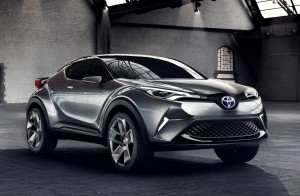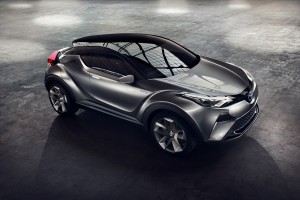Toyota’s newest iteration of its C-HR concept vehicle features a variety of more practical enhancements that forced observers to wonder if the crossover might be moving toward production? Wonder no more, it is.
The updated concept represents a step toward commercialization, with changes such as the shift from a three-door to a five-door format made from a practicality standpoint, the automaker said. Additionally, the roof color scheme has been changed from a two-tone (blue and black) to a uniform glossy black color scheme.
The Japanese maker said it plans to have a mainstream version of the C-HR at the Geneva Motor Show next March. The C-HR was initially introduced during the 2014 Paris Motor Show and attracted enough attention to force the maker to consider the long-term prospects.
The prospects turned out to be at least good enough to push it forward. The C-HR uses Toyota’s New Global Architecture (TNGA), an integrated development program for vehicle platforms and powertrain components.
TNGA allows Toyota to create vehicles with improved chassis rigidity, handling stability, and comfort. Additionally, Toyota aims to give the concept an engine with thermal efficiency of over 40%, as well as further improving fuel efficiency by making the hybrid system―including the motor and battery―smaller and more lightweight.
(Toyota C-HR moves closer to production. For more, Click Here.)
The current concept also appears to help the Japanese maker pull together some of the design details it has been showing off in other recent offerings, including the new Camry and Corolla models and the all-new Prius hybrid that will get its first public showing in Frankfurt this week.
“This highly innovative design study for a stylish, lightweight and dynamic hybrid crossover is designed to stand out in an increasingly homogeneous marketplace,” Toyota declared in a release describing its plans for the 2015 Frankfurt Motor Show.
(Click Here for details on Nissan’s Gripz: the next Juke?)
It describes the five-door C-HR’s styling as part of its new “diamond-shaped” design language. And that seems to fit the angular and crisp-edged concept vehicle. The theme extends from the broad air intakes of the front fascia to the unusual kick-up of the rear quarter panel, and even to the “diamond-cut” spokes of the show car’s 21-inch wheels.
The hatchback’s rear glass tapers down aggressively, flowing into a more muscular lower body than the typical hybrid. That sporty theme is underscored by the bold front grille and broad wheel arches. While the C-HR shares the global architecture with the new Prius, it’s unknown what else it may share.
(To see more about Nissan chief Carlos Ghosn’s plans to hold the course on EVs, Click Here.)
Toyota was notably silent about the drivetrain in the 2016 Prius, other than promising it will deliver a 10% boost in fuel economy. With the C-HR, the maker suggests it is motivated by a “new, advanced, full-hybrid powertrain (that) offers a uniquely engaging driving experience matched to 21st Century driving conditions.”


